#l'aurore et céphale
Explore tagged Tumblr posts
Text

L'Aurore et Céphale or Aurora and Cephalus (1810), (detail), by Pierre-Narcisse Guérin (French, 1774–1833), oil on canvas, 254.5 × 186 cm, Musée du Louvre, Paris
#l'aurore et céphale#aurora and cephalus#pierre-narcisse guérin#painting#my upload#musée du louvre#louvre museum#louvre#mythology#greek mythology#roman mythology#mythological painting#mythological art#aurora#cephalus#dawn#eos#painting detail#detail#oil on canvas#art#fine art#19th century
8 notes
·
View notes
Text

Nicolas Poussin, 1594-1665
Céphale et l'Aurore, ca.1624/25, oil on canvasm 79x152 cm
Collection Hovingham Hall, York, Worsley Collection
6 notes
·
View notes
Text
Wealth & Status in Baroque and Rococo
Having it all must be tough :(
There are never ending decisions to make, about silly things like ideal garden shrubbery height, drapery thread count, ornate frames, silver, or gold? To show it all off or to cover it up? To spend or to save? To invest in the Church or one's own extravagant lifestyle? Virtuous piety or worldly comforts?
To nurture Faith or Ego?
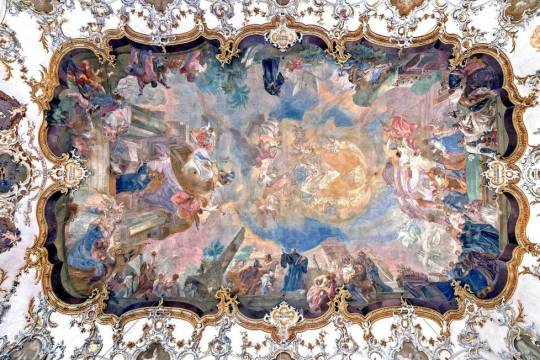
Ceiling painted by Johann Baptist Enderle, 1772
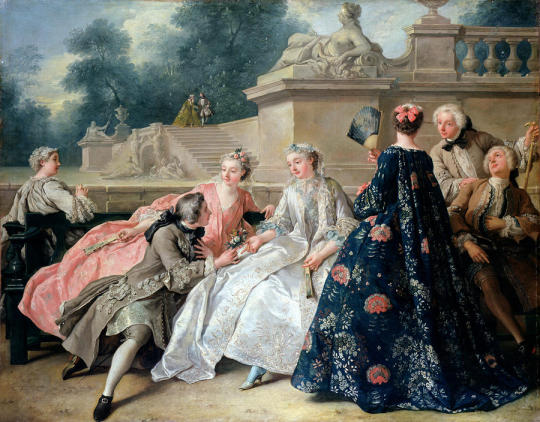
Jean-François de Troy, The Declaration of Love (1731)
All these competing ideals are exactly what set the Baroque and Rococo periods apart.
Let's start at the beginning - well, sort of - with Baroque.

Artemisia Gentileschi, Judith and Holofernes 1612-13
Throughout Europe Catholicism sees a decline in followers going into the 17th century, due to popularization of Marin Luther's Protestant reformation.
Protestantism came as a response to shady behavior within the Catholic Church, which had previously held unchallenged cultural and political power. This 'divine' power within the Church attracted wealth, and wealthy people looking to buy in.

I cannot stress enough how motivated by money the Catholic Church was at this time. Many Popes like Leo X actually sold physical certificates called 'indulgences' which were essentially Fast-passes through Purgatory, should its keeper die before confessing their sins in penance.
Through generous donations to the Catholic Church, one could actually buy themselves a ticket into heaven, circa ~ 1550.
This wasn't great optics to German monk, and founder of Protestantism, Martin Luther. And many people agreed, causing a novel decline in Catholicism. The Roman Catholic Church desperately needed a rebrand.

Caravaggio [?] , The Crowning with Thorns, 1603
Baroque paints Catholicism in a more virtuous, penitent, moody, and modest light. Visual elements like high contrast light and shadows, mostly religious imagery, "normal" looking figures that no longer strive to be the Renaissance's perfect man, nor Rococo's dashing picture of youth and indulgence, they look like us.
It's hard to say if the Baroque art movement really saved the Church from losing followers, but it did spark a global popularization of Baroque and is responsible for subsequent movements in fine art and architecture across the world!
ie. the global Baroque, Rococo, heavy influences on the Dutch golden age of painting.
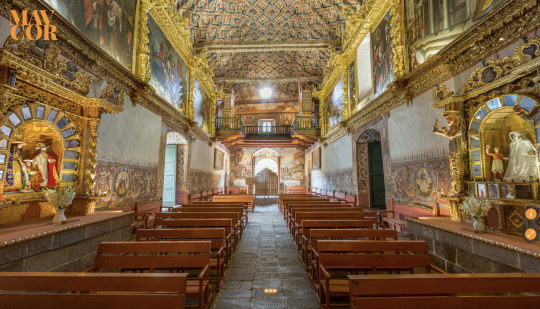
Church of St. Peter of Andahuaylillas - Peru, 1620s
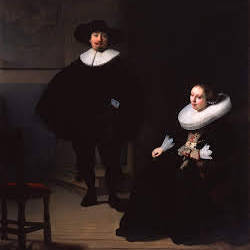

Rembrant, Lady and Gentleman in Black and Christ in the Storm on the Sea of Galilee, 1633, Dutch [missing from ISG Museum since 1990]

Jean-Honoré Fragonard, The Progress of Love: Love Letters, 1771-72, French
In the century to follow, Baroque artwork would become a status symbol in itself, along with its pious and devout lifestyle.
French aristocrats and artists like Fragonard coming into the 18th century rejected this ideology, along with King Louis XIV's frugal, somewhat Baroque style of ruling. Rococo takes clear visual elements of Baroque and applies them to a generally more frivolous, lighthearted, romantic subject matter, with clear emphasis on material wealth.
Wealth was shown and represented in excess, lifestyles full of lush scenery and architecture like Versailles. Material goods and conspicuous consumption ruled the aristocratic nobility (art buying community) at the time.
In the Rococo period once again, in Renaissance fashion, art patrons are shifting toward a search for aesthetic perfection, beauty, and divinity in humans and on earth.
A harsh contrast from a hundred years prior, in the midsts of Baroque's influence of frugality, devotion to faith, and denouncement of worldly comforts. This shift could have many catalysts, including the continuing spread of Protestant religions, or the rebellion against a previously strict, sometimes oppressive, religious church-state under the reign of Louis XIV.
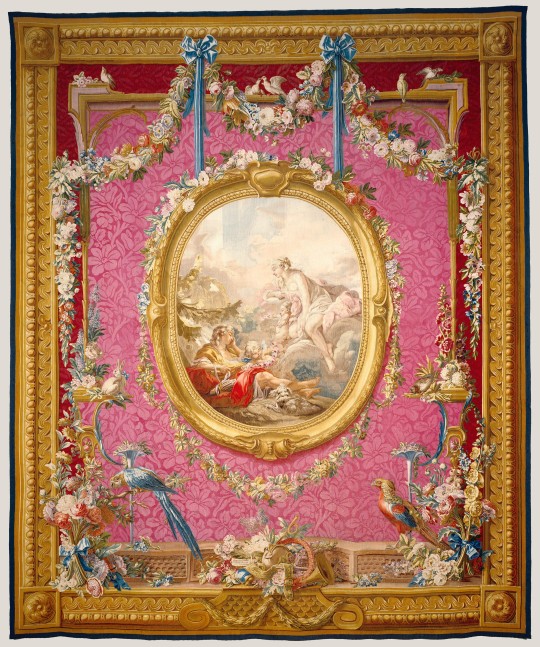
Tapestry L'Aurore et Céphale, from Les Tentures de François Boucher Series, Painted by Francois Boucher, 1776-77, French
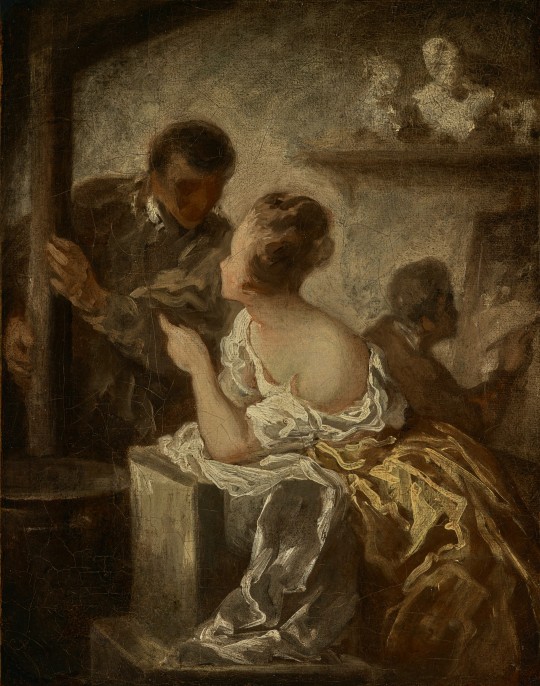
The Studio, Honoré Daumier, 1870, French
Ultimately, today the Rococo period is iconic in reference to the French Revolution.
Similarly to Rococo's start, as a rebellion against a meek and mild social norm, Rococo's end is tied to the death of the French noble class; at the hands of French citizens who were facing the consequences (famine, poverty, poor living conditions) of the French Nobility's over-indulgent, expensive lifestyle.
I can only assume that after the torches, pitchforks, and guillotining of the French Monarchy, Rococo's frills and embellishments probably seemed pretty... cringe.

Portrait of the Marquise de Pompadour by Maurice Quentin de La Tour, 1755 (Rococo)
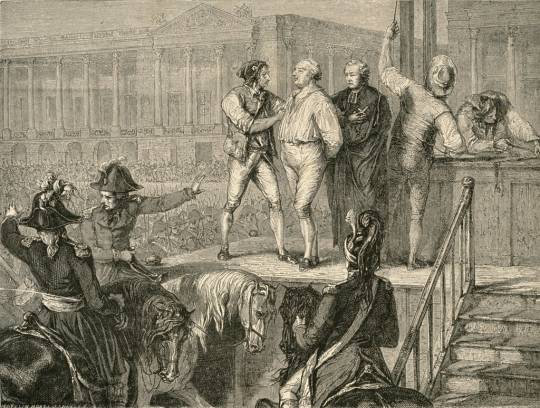
The Execution of Louis XVI by H. de la Charlerie, 1793 (Neo-classical)

The Death of Marat, Jacques-Louis David, 1793 (Neo-classical)
#art history#art#neo classical#baroque#global baroque#18th century art#17th century art#rococo#french revolution#renaissance#1800s#1700s#1700s fashion#1800s fashion#17th century#18th century#isabella stewart gardner museum#art theft#stolen art#classical art#classical paintings#architecture#religious art#religious architecture
6 notes
·
View notes
Text

"L'Aurore réincarnée"
La genèse de cette oeuvre vient de l'épithète "êrigéneia", ou "l'enfant du matin" que le poète Hésiode attribue à la déesse Eos. C'est le mot "enfant" en particulier qui m'a poussé à intégrer la symbolique bouddhique de cette oeuvre avec le Samsara, la roue des réincarnations, qui forme une auréole autour de la tête divine.
Chaque jour, la déesse se réincarne pour apporter au monde la lumière du matin, cette réincarnation perpétuelle la laisse perpétuellement dans un état enfantin.
L'auréole est enfermée par un ouroboros, inspiré de celui de la DDHC de 1789 ; il st un symbole de pérennité.
L'aspect général de la déesse est inspirée de la statuaire antique gréco bouddhique.
Je pense faire de ce dessin la couverture de mon recueil de poésie "Amor Mundum Fecit". J'espère tellement que je pourrais le faire éditer par une maison d'édition, je pense qu'il est important pour notre époque, pour les futures générations (en vérité, je suis terrifié par l'idée même que mon oeuvre soit rejetée). Le dessin sera associé au poème "L'apprentissage", une relecture du mythe d'Aurore et Céphale.
Par mes oeuvres, je tente de créer une nouvelle iconographie basée sur mes propres interprétations mythologiques. Je veux dépoussiérer l'antique pour le revivifier.
Le titre exact est "L'Aurore chaque jour se réincarne pour cueillir la rose de la vie et apporter au monde la lumière du matin" (mon plus long titre à ce jour.)
1 note
·
View note
Photo

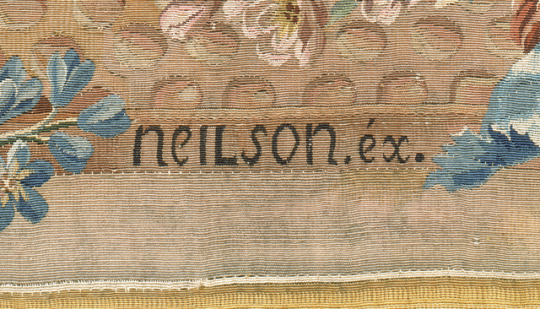
▪Tapestry: L'Aurore et Céphale, from Les Tentures de François Boucher Series. Culture: French Place of origin: France Date: 1776 - 1777 Medium: Wool and silk
139 notes
·
View notes
Photo

Pierre-Narcisse Guérin (Baron Pierre-Narcisse Guérin) - L'Aurore et Céphale (Aurora and Cephalus), 1814, Louvre Museum (Musée du Louvre), Paris (France).
#art#arte#artist#Paris#classic#classical#classical art#classical paintings#parisienne#france#french#french artist#french art#French Painter#painting#paint#painter#pierre-narcisse guerin#baron pierre-narcisse guerin#pierre narcisse guerin#p.n. guerin#l'aurore et cephale#aurora and cephalus#1814#1800s#1800#louvre museum#musee du louvre
2K notes
·
View notes
Text

François Boucher, L'Aurore et Céphale, 1733, Musée des Beaux-Arts, Nancy
x
#painting#artwork#beautiful#art#18th century#rococo#french#french art#françois boucher#oil painting#oil on canvas#greek mythology#aurora#lovers#love
29 notes
·
View notes
Photo

Pierre-Narcisse Guérin - L'Aurore et Céphale
26 notes
·
View notes
Photo

À L'AURORE DE L'AMOUR... Regardez "Amour, t'es là? - Magda Giannikou" sur YouTube https://youtu.be/xOdntlJH4Ps Dans le contexte animé de l'Académie de France, de la réflexion des peintres français sur les modèles traditionnels en rapport avec Rome, émergent de nouvelles propositions figuratives qui interrogent l'Ancien et la Nature. François Boucher dans le grand tableau Aurore et Céphale, réalisé en 1733 - Nancy, Musée des Beaux-Arts - est un exemple emblématique de la volonté des artistes français de s'éloigner des modèles traditionnels, en les réinterprétant dans de nouvelles directions. Le sujet, tiré des Métamorphoses d'Ovide, s'éloigne des exemples de la statuaire classique pour évoquer les nouveautés du langage moderne. Boucher retravaille le mythe, accentuant l'élément sensuel - et renversant les rôles habituels de la séduction - donne à Aurore une place prépondérante. #culturejaiflash https://www.instagram.com/p/CbgM1YdMdcT/?utm_medium=tumblr
0 notes
Audio
(vía https://open.spotify.com/track/6KLzlYMhS7FVooY1ZdGwdY?si=sZFYTOnAS_qm6k4rwRjluw)
0 notes
Photo


Jean Bruno Gassies, 1786-1832
L'Aurore et Céphale, ca.1800/25, huile sur toile, 131x144.5 cm
Musée du Louvre, Inv. 8619
13 notes
·
View notes
Photo

Nicolas Poussin, 1594-1665
Céphale et l'Aurore, ca.1624/25, oil on canvas, 79x152 cm
Hovingham Hall, York, Worsley Collection
3 notes
·
View notes
Photo


After François Boucher, 1703-1770
Tapestry: L'Aurore et Céphale, from Les Tentures de François Boucher Series, 1776-1777, wool and silk; modern linen lining, 382.9×316.5 cm
The J. Paul Getty Museum (Los Angeles), Inv. 71.DD.469
6 notes
·
View notes
Photo

Pierre-Narcisse Guérin - L'Aurore et Céphale
49 notes
·
View notes
